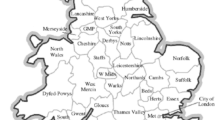Abstract
This paper examines changes in female criminality. Data were obtained from 1943 through 1998 on six index crimes: murder, robbery, assault, burglary, auto theft, and larceny. Rape and arson are not included because rape is almost exclusively a male crime, while statistics for arson have not been consistent for the period studied. A review of the literature on female crime is presented. Percentage differences between males and females were obtained for specific crimes for each year. A regression line was computed for this difference by year. Each line is characterized by R2, as a measure of confidence in future predictions and “b” levels to determine slope, and the expected year in which male and female crime will achieve equality if current trends continue. The authors also suggest using the year generated as an index on which to compare growth or decline of female crime.
Similar content being viewed by others
References
Adler, F. (1975).Sisters in crime. New York, NY: McGraw-Hill.
Adler, F. (1980). The interaction between women's emancipation and female criminality: A cross-cultural perspective. pp. 150–166 in S. Datesman & F. Scarpitti (eds.),Women, crime, and justice. New York, NY: Oxford University Press.
American Correctional Association. (1990).The female offender: What does the future hold? Washington, DC: Saint Mary's Press.
Black, D., (1970). The production of crime rates.American Sociological Review 35, 733–48.
Bloom, B., M. Chesney-Lind & B. Owen. (1994).Women in California prisons: Hidden victims of the war on drugs. San Francisco, California: Center On Juvenile and Criminal Justice.
Bowker, L. H. (1978).Women, crime, and the criminal justice system. Lexington Mass.: Lexington Books.
Bowker, L. H.. (1981).Women and crime in America. New York: MacMillan Publishing Company, Inc.
Box, S. & C. Hale. (1984). Liberation /Emancipation, economic marginalization, or less chivalry: The relevance of the three theoretical arguments to female crime patterns in England and Wales, 1951–1980.Criminology 22, 473–497.
Bureau of Justice Statistics. (1994)Women in prison. Washington, DC: U. S. Department of Justice.
Bureau of Justice Statistics. (1995).Bulletin: Prisoners in 1994. Washington, DC: Government Printing Office.
Chesney-Lind, M. & J. Pollock. (1995). Women's prisons: Equality with a vengeance. Pp. 155–176 in A. Merlo & J. Pollock (eds.),Women, law, & social control. Boston, Mass. Allyn and Bacon.
Chesney-Lind, M. (1997).The female offender: Girls, women, and crime. Thousand Oaks, Cal.: Sage Publications.
Crites, L. (1976).The female offender. Lexington, Mass.: Lexington Books.
Cole, G. (1992).The American system of criminal justice. Pacific Grove, California: Brooks/Cole Publishing Company.
Datesman, S. & F. Scarpitti. (1980),Women, crime, & justice. New York, NY: Oxford University Press.
Federal Bureau of Investigation. (1943–1999).Crime in the United States. Washington, D.C.: U.S. Government Printing Office.
Flowers, R. B. (1995).Female crime, criminals and cellmates. Jefferson, NC: McFarland.
Forsyth, C. & B. Foster. (1993). Trends in female criminality, 1943–1991.Free inquiry in creative sociology 21(2), 135–140.
Forsyth, C. & T. Marckese. (1995). Female participation in three minor crimes: A note on the relationship between opportunity and crime.International Journal of Sociology of the Family 25(1), 127–132.
Forsyth, C., S. Roberts & R. Gramling. (1993). The putative problem of female crime. Pp. 23–41 in Concetta Culliver (ed.)Female criminality: The state of the art. New York: Garland.
Forsyth, C. & N. Shover. (1986). No rest for the weary... Constructing a problem of elderly crime.Sociological Focus 19, 375–386.
Giordano, P. and S. A. Cernkovich. (1979). On complicating the relationship between Liberation and Delinquency.Social Problems 26(April), 467–481.
Healey, J. F. (1993).Statistics: A tool for social research. Belmont, California: Wadsworth Publishing Company.
Krohn, M.D., J.P. Curry & S. Nelson-Kilger. (1983). Is chivalry dead? An analysis of changes in police dispositions of males and females.Criminology 21 (August), 417–438.
Leonard, E. B. (1982).Women crime & society: A critique of criminology theory. New York, NY: Longman Inc.
Mukherjee, S. K. and R. W. Fitzgerald. (1981). The myth of rising female crime. pp 126–166 in S. Mukherjee & J. A. Scutt (eds.),Women and crime. Sydney, Australia. Australian Institute of Criminology.
O'Brien, R., D. Shichor & D. L. Decker. (1980). An empirical comparison of the validity of UCR and NCS Crime Reports.Sociological Quarterly 21, 391–401.
Pollock-Byrne, J. M.. (1990).Women, prison, & crime. Pacific Grove, California. Brooks/ Cole Publishing Co.
Simon, R. (1975).Women and crime. Lexington, Mass: Lexington Books.
Simon, R. J., and M. Benson. (1980). Evaluating changes in female criminality. pp. 549–571 in M.W. Klein & K.S. Leilmann (eds.),Handbook of criminal justice evaluation. Beverly Hills, CA: Sage.
Smart, C. (1977).Women, crime, and criminology: A feminist critique. Boston, Mass: Routledge & Kegan Paul.
Steffensmeier, D. J.. (1978). Crime and the contemporary woman: An analysis of changing levels of female property crime, 1960–1975.Social Forces 57, 566–584.
Steffensmeier, D. J.. (1980). Sex differences in patterns of adult crime, 1965–77: A review and assessment.Social Forces 58(June), 1080–1108.
Steffensmeier, D. J. (1983). Organizational properties of sex-segregation in the underworld: Building a sociological theory of sex difference in crime.Social Forces 61 (October), 37–50.
Steffensmeier, D. J. & R. M. Steffensmeier. (1980). Trends in female delinquency: An examination of arrest, juvenile court, self-report, and field data.Criminology 18(May), 62–85.
Steffensmeier, D. J. & C. Streifel. (1992). Time-series analysis of the female percentage of arrests for property crimes, 1960–1985: A test of alternative explanations.Justice Quarterly 9(1), 77–103.
Visher, C. A.. (1983). Gender, police arrest, and the notions of chivalry.Criminology 21 (February), 5–28.
Weis, J. G.. (1976). Liberation and crime: The invention of the new female criminal.Crime and Social Justice 6(Fall–Winter), 17–27.
Author information
Authors and Affiliations
Rights and permissions
About this article
Cite this article
Forsyth, C.J., Wooddell, G. & Evans, R.D. Predicting symmetry in female/male crime rates. J Police Crim Psych 16, 1–9 (2001). https://doi.org/10.1007/BF02805176
Issue Date:
DOI: https://doi.org/10.1007/BF02805176



